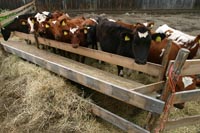Producers Can Point Kentucky Beef Toward Global Market Success
Producers Can Point Kentucky Beef Toward Global Market Success


As the largest cattle-producing state east of the Mississippi River, Kentucky is home to more than 1 million beef cows and more than 40,000 beef producers, providing it with an opportunity to compete in the global market.
At the 2006 Kentucky Beef Conference at the Fayette County office of the University of Kentucky Cooperative Extension Service, many of these producers gathered to share ideas and to learn about global marketing from nationally known expert Randy Blach, executive vice president of Cattle-Fax. Cattle-Fax supplies its members in all segments of cattle production and feeding throughout the United States with timely market information, analyses and educational programs to assist them in making better decisions.
“The smallest supplies and the smallest production levels are behind us,” Blach told the crowd. “We are going to have more cattle coming through our systems over the next three to four years. Prices have peaked. The only thing that hasn’t quite peaked yet is bull prices, and they will in 2006. And, you can argue whether bred cow prices have peaked.”
The peaks are part of the cattle cycle where high prices are followed by transition years with lower prices. Blach told producers the most exciting aspect of the cattle business today is that those involved are moving away from a commodity mentality and toward a product focus.
University of Kentucky Agricultural Economist Kenny Burdine said the past several years have been some of the most profitable for cow-calf producers in Kentucky, largely due to extremely high levels of calf prices.
“Profitability tends to encourage expansion, which will eventually lead to increased beef supplies and lower prices,” he offered. “Producers who want to be in the cattle business long term have the opportunity to use some of their current profits to make investments that will lower their cost of production.”
Burdine added that improvements in genetics, forage programs and facilities are just a few of the ways producers can improve efficiency and lower production costs. By lowering production costs, producers should be better able to survive lower calf prices that likely lie ahead, he said.
More than 96 percent of the world population lies outside the United States. Blach said producers need to keep this important fact in mind when making marketing decisions.
“We have to deliver what we promised to our consumer,” Blach said. “The global market is here. Ninety-six percent of the world market is outside our borders and we need to do what the market wants; it’s really pretty simple.”
Blach referred to producers who have been participating in source verification programs in the past three years and those who have raised cattle to qualify for natural programs. The premiums for these cattle have been from $20 to $30 a head, he said.
“That premium for quality may go away and become more of a discount for poorer quality animals,” he added. “All these things just add up, and that’s part of the differentiation that is taking place in the market.”
Blach said that the global market is giving producers an opportunity to choose where they fit and what part of the market they want to participate in, and producers should not take that opportunity for granted.
“My family has been in the cow-calf business since 1877 out in eastern Colorado,” he said. “Clear up into the 1970s we were passive. We didn’t make any breeding decisions with the market in mind. We were making those decisions based on what we wanted. The challenge I want to give producers is to decide where they want to play in this overall market.”
